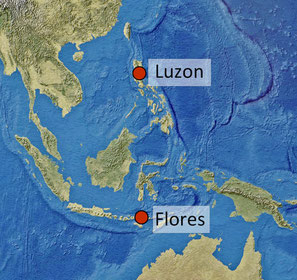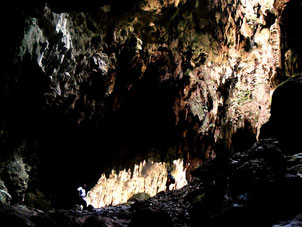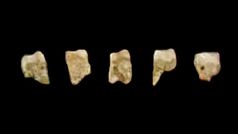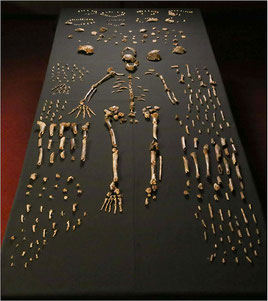
Back in 2002, one of the most surprising discoveries in history of the study of human evolution was made. Diminutive hominins named Homo floresiensis, popularly known as Hobbits (despite the lack of evidence for them having hairy feet!), were discovered on the Indonesian island of Flores. Their discovery challenged much of the received wisdom of palaeoanthropology at that time.
The Flores hominins were small at about 1 metre in height. Their brains were no bigger than that of a chimpanzee and smaller relative to their body size than even for early members of the genus Homo. Overall, they were superficially similar to the earliest forms of the genus Homo or even to the earlier genus Australopithecus - that is hominins that last lived over 2 million years ago. Furthermore, hominins of this type were previously known only from the continent of Africa.

Flores is in southeast Asia, far away from Africa, and more surprisingly the Flores hominins were dated to around 50,000 years ago (the finds were originally dated to as recently as about 11,000 years ago).
However, Homo floresiensis is yesterday's new, so to speak, and this post is about something announced in 2019 (though the first remains were found in 2007). The newcomers to the hominin gang have been named Homo luzonensis after Luzon Island in the Philippines. However, the Flores hominins may still be relevant to this story of the newcomers.

The finds were excavated from Callao cave and are, as is so often the case, fragmentary. The specimens comprise seven teeth, two hand bones, three foot bones and one thigh bone and seem to represent two adults and one child. Interestingly, the excavation has been dated to 50-67,000 years ago, so about the same age as Homo floresiensis. Though both in southeast Asia, Flores and Luzon island are separated by around 1600 miles (2600 km).

So, what did Homo luzonensis look like and what do we know about their lifestyle? Well, they appeared to have been small, perhaps not much more than a metre in height and so similar to Homo floresiensis. They seem to have walked on two legs but had curved toe bones, which resembles the anatomy of the australopithecines and indicates the ability to climb trees well.

But is Homo luzonensis closely related to the australopithecines and descended from an early - and as of yet unknown - dispersal out of Africa by a species more primitive than Homo erectus? Or did they actually evolve later on, perhaps from Homo erectus, locally in southeast Asia, shrinking in size and developing novel anatomical traits which resemble australopithecines only at a superficial level? Well, like many aspects of human evolution, this is still very much a mystery. However, based on purely anatomical grounds a more ancient origin from early Homo or Australopithecus is perhaps more likely than a more recent one from Homo erectus.
So much like Homo floresiensis, we have a hominin that would have seemed at home in Africa of over 2 million years ago. However, as improbable as it would have been two decades ago, we now know that small-bodied and small-brained, archaic hominins lived on the islands of southeast Asia at the same time that modern humans, Homo sapiens, were spreading around the globe. Whether modern humans had anything to do with the demise of Homo floresiensis and Homo luzonensis we simply can't say.
Another point to consider is how did these hominins actually get to the islands of southeast Asia? Some sort of accidental arrival, such as being washed up in relatively large numbers by a natural event like a tsunami, is plausible. We know that such seemingly unlikely events do happen from time to time. But perhaps extinct hominins were more capable than we often give them credit for. Maybe they travelled on simple rafts in search of new food resources or living habitats. Either way, what we do know is that hominins did arrive on these islands over open sea by some means and it's exciting to think what other finds await discovery in the region that could shed yet more light on human origins.
Nobody would predicted the discovery of Homo floresiensis and Homo luzonensis a couple of decade ago. But their very discovery should remind us how much we have to learn about hominin evolution. There are still large areas of the globe with very little evidence of hominin evolution, of either fossils or archaeology. It is entirely possible that australopithecines or other small-bodied hominin species are waiting to be found outside of Africa.

A final point that is also pertinent to this story of late-surviving diminutive hominins is the 2013 discovery of Homo naledi in South Africa. Based purely on its anatomy, Homo naledi would perhaps seem a good candidate for the ancestor of Homo erectus, who appeared about 1.8 million years ago. However, rather astonishingly the finds have recently been dated at roughly 300,000 years old. Homo naledi then could represent a relict species closely related to the origin of Homo (or Homo erectus which it resembles in a number of respects) that remained conservative in its anatomy for 2 million years or so. Homo floresiensis and Homo luzonensis could also be archaic relict species. If so, somewhere outside of Africa we should expect to find similar hominins but of a greater antiquity than the island hominins. With a stroke of luck hopefully something exciting will turn up soon!
If you are interested in learning more about human evolution please take a look at my range of online courses.
The Homo luzonensis finds were published in the journal Nature on the 10 April 2019.
Image credits
Homo floresiensis: Ryan Somma: CC BY-SA 2.0
Callao cave: Ervin Malicdem: CC BY-SA 4.0
Homo luzonensis foot: Luzonensis: CC BY-SA 4.0
Homo luzonensis teeth: Luzonensis: CC BY-SA 4.0
Homo naledi: Lee Roger Berger research team: CC BY 4.0
LEARN ONLINE ABOUT HUMAN EVOLUTION
If you want to learn more about human evolution please consider taking one my online courses on human evolution. No prior knowledge is required, all that is required is an passion in learning about human origins!
There is a 30-day money back guarantee on all courses. Free samples are also available for all courses so you try them out and see if you like them before even paying.


Write a comment